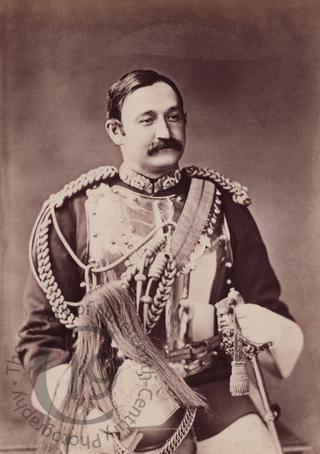
Colonel Frederick Burnaby (Royal Horse Guards)
A cabinet card portrait of Frederick Gustavas Burnaby (1842-1885), ‘The Last of the Cavaliers.’
Born the son of a land-owning parson at Bedford on 3 March 1842, and educated at Bedford Grammar School and Harrow, Frederick Burnaby bought a commission in the Royal Horse Guards in 1859, but it was as a journalist and travel writer that he first came to the public’s attention. His hazardous and arduous journeys took him through remote and often war-torn parts of Europe, Asia and North Africa. The books that he published include A Ride to Khiva (1876) and Oh Horseback through Asia Minor (1877). The reports that he sent back to The Times made him the toast of London society, although his style was not without its critics. He was the journal's correspondent in Spain during the Carlist Wars in 1874; later he sent back despatches from the Russo-Turkish War (1877-78) which castigated the government for not supporting the Turkish cause. A flamboyant exhibitionist and an avid bodybuilder, he soon became known as the strongest man in the Army. He was also a keen balloonist, making a total of 19 ascents, including a crossing of English Channel. His name was seldom out of the papers and he even helped found a magazine, Vanity Fair, and gave it the name it still bears today. His portrait by Tissot in the National Portrait Gallery depicts a magnificent, nonchalant dandy, casually reclining in a perfectly cut uniform and elegantly smoking a cigarette.
His proximity to battle had thrilled him – ‘a sensation worth ten years of a man’s life’ – and he joined an expeditionary force to the Sudan to punish the Mahdi. Although he fought with reckless bravery, his use of a hunting shotgun, as opposed to the regulation Army-issue rifle, implied that he saw the killing of Dervishes as a pleasurable sport, rather than a duty, and his celebrity tipped over into notoriety.
By now he was colonel of the Blues – a division of the Household Cavalry – but he had attained his rank only by seniority, not through his military exploits. In 1884 he joined another expedition to the Sudan, sent to relieve a besieged Gordon at Khartoum. He never returned. On 17 January 1885 he was cut down in battle, sword in hand, by a dozen Dervishes. A fellow officer later wrote that ‘his face bore the composed and placid smile of one who had been suddenly called away in the midst of a congenial and favourite occupation, as undoubtedly was the case.' The press celebrated the passing of a British hero, albeit a vainglorious one.
Photographed by Thomas Fall of 9 and 10, Baker Street, London.
Code: 126336




